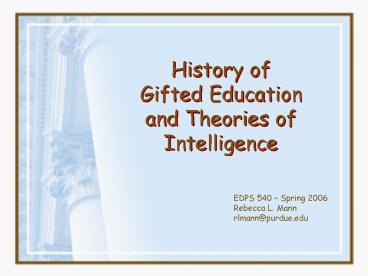EDPS 540 Spring 2006 PowerPoint PPT Presentation
1 / 24
Title: EDPS 540 Spring 2006
1
History of Gifted Educationand Theories of
Intelligence
- EDPS 540 Spring 2006
- Rebecca L. Mann
- rlmann_at_purdue.edu
2
Gifted depends on the values of the culture
- Primitive Civilizations
- Survival of the fittest
Ancient Civilizations
- Greeks
- Sparta - valued military skills
- Athens - valued academics for upper class
- Romans - valued architecture, engineering, law
- Chinese - valued multiple talents
- Japanese - educated children based on social
- class
3
(No Transcript)
4
Pre-Renaissance Europe
- Church as keeper of knowledgeRenaissance
Europe - valued art, literature, architecture
5
Sir Francis Galton - 1822-1911
- Anthromopetric Lab
- Measured physical and sensory capacities
- Intelligence was fixed, in-bred, inherited
6
(No Transcript)
7
Cesare Lombroso -1836 - 1909
- Genius is a symptom of hereditary degeneration
Alfred Binet - 1857-1911
- Contributed notion of mental age
- First standardized IQ test
- The scale, properly speaking, does not present
the measure of intelligence because intellectual
qualities are not superposable and therefore they
cant be measured as linear surface are
measured. 1904
8
Early America
- Services for gifted education sparse
- Occasional programs in the form of tracking,
telescoping, acceleration, grade-skipping, and
special schools - By 1920, two-thirds of major U.S. cities had
gifted programs
9
- 1920s and 1930s and 1940s
- Declining programs
- Equity became focus, interest in gifted waned
- Great Depression
- World War II
10
Charles Spearman - 1863 - 1945
- Two factor theory of intelligence
- g general factor and s specific ability
L.L. Thurstone - 1887 - 1955
- Intelligence is really several primary mental
abilities - Seven relatively different abilities
- Factor analyzed intelligence and
- perception tests
11
Lev Semyonovich Vygotsky - 1896-1934
- Modern Constructivism Sociocultural Theory
- Humans have ability to alter their environment
- Zone of Proximal Development
- Amount of learning possible when given
instruction
12
Leta Hollingworth - 1886 - 1936
- Nuturant Mother of gifted education
- Highlighted social and emotional needs of gifted
- Wrote first college text on gifted, taught first
course - Established gifted programs in New York City
13
Lewis Terman - 1877-1956
- Father of gifted education movement
- Supervised modification of Binet-Simon test
- First longitudinal study of gifted children
- Study began in 1922, continued by others after
his death - Students were physically, socially and
psychologically healthier than the average
14
(No Transcript)
15
1957 - Sputnik Effect
- Resurgence of gifted education
- Identification, ability grouping, acceleration,
telescoping
1963 - Death of JFK LBJs Great Society
Special Education moved to the forefront, gifted
lagged
16
Jean Piaget - 1896 - 1980
- Four stages of mental growth in children
- Qualitative not quantitative
David Weschler - 1896 - 1981
- Took Binet-Simon and reclassified it
- Intelligence is multifacted
- Developed tests for children and
- adults (WISC WAIS)
17
J. P. Guilford - 1897 - 1988
- Three dimensional Structure of the Intellect
- Intelligence too complicated to be summed up in
one number or g factor
18
Raymond Cattell - 1905 - 1998
- Fluid Intelligence Intelligence which allows us
to learn new things, regardless of past
experience. (Innate Intelligence) - Crystallized Intelligence Ability to solve
problems based upon previous experience.
19
- 1972 - Marland Report
- Resurgence with Federal definition of giftedness
- 1988 - Javits Gifted and Talented Students
Education Act - 1990 - lost federal funding
- 1993 - funding restored
20
Joseph Renzulli - 1936 -
- Three ring model of giftedness
- Broadened concept
- Multiple criteria
- Schoolwide Enrichment Model
21
WHAT MAKES GIFTEDNESS?
Task Commitment
Above Average Ability
Creativity
A
I
U
C
C
T
P
22
Howard Gardner - 1943 -
- Theory of Multiple Intelligences
- Intelligence is multifacted
- Not designed as an educational prescription
- Linguistic
- Logical-mathematical
- Musical
- Spatial
- Bodily-kinesthetic
- Interpersonal
- Intrapersonal
- Naturalistic
23
Robert Sternberg - 1949 -
- Triarchic Theory of Human Intelligence
- Based on relationship between
- intelligence, environment, the external
- and internal world
- First to include creativity and practical
- knowledge
24
Sternbergs Theory of Intelligence
Sternberg believes that intelligence is comprised
of three separate, though interrelated, abilities

